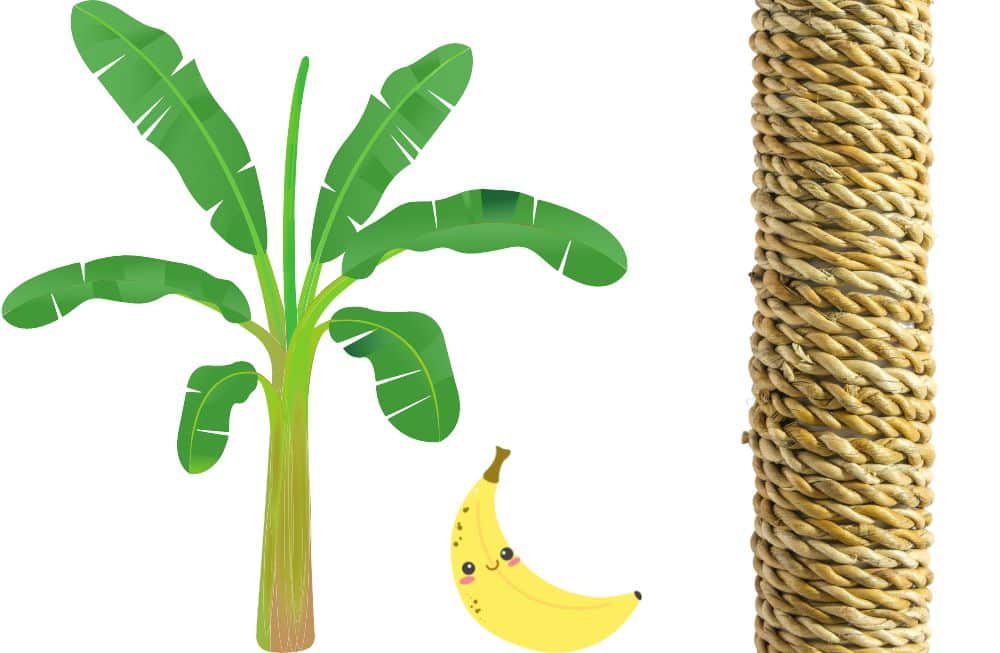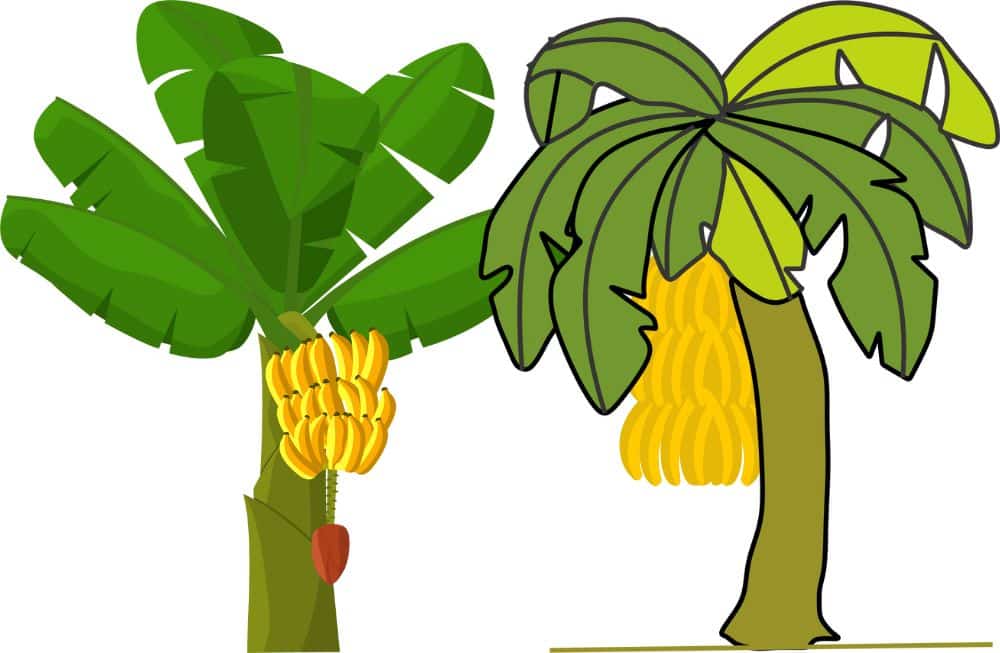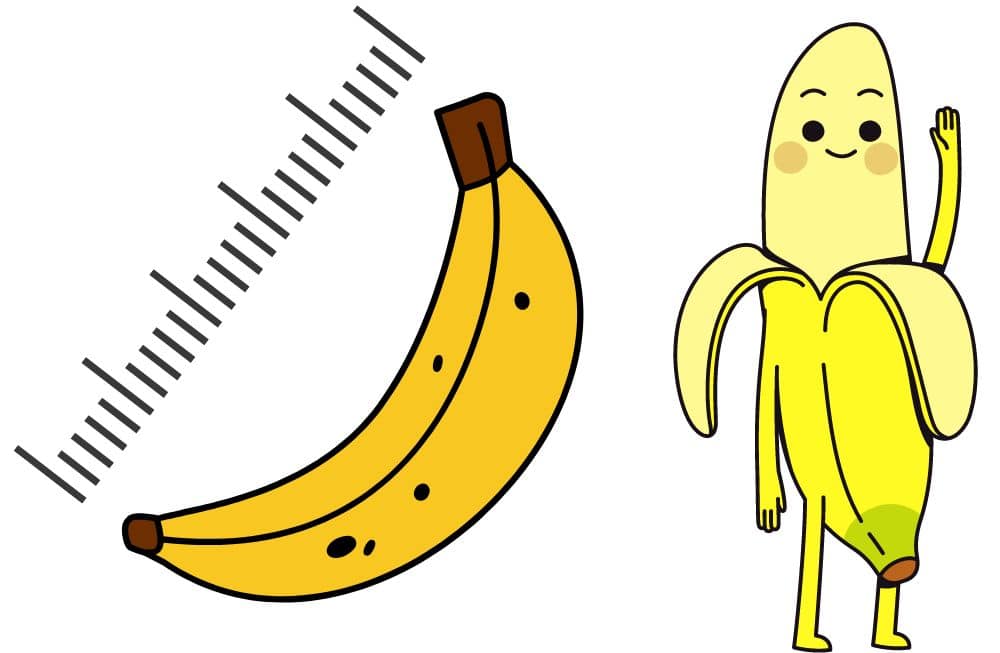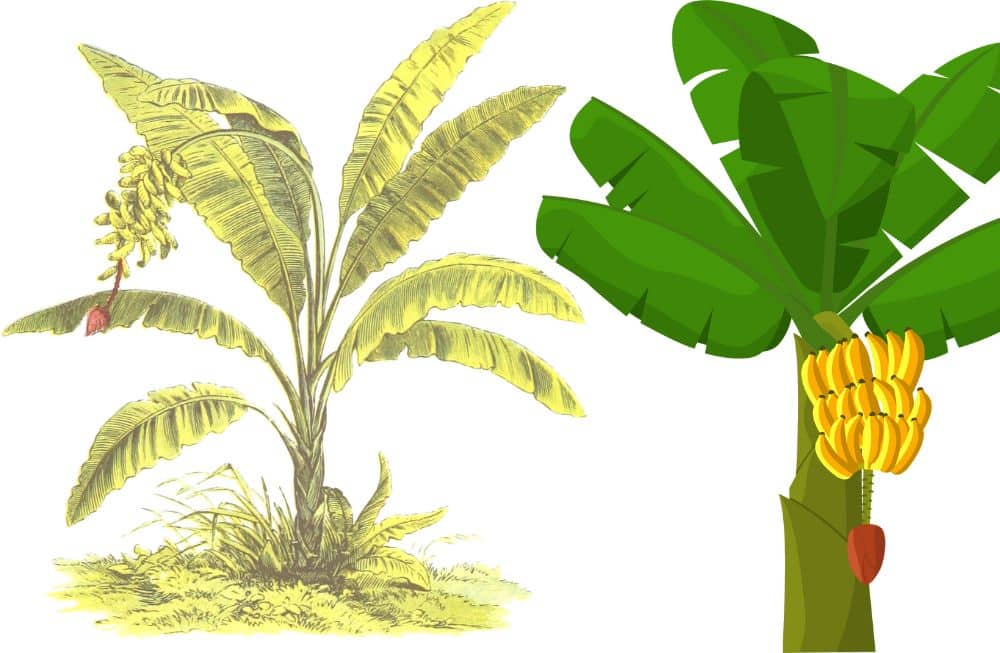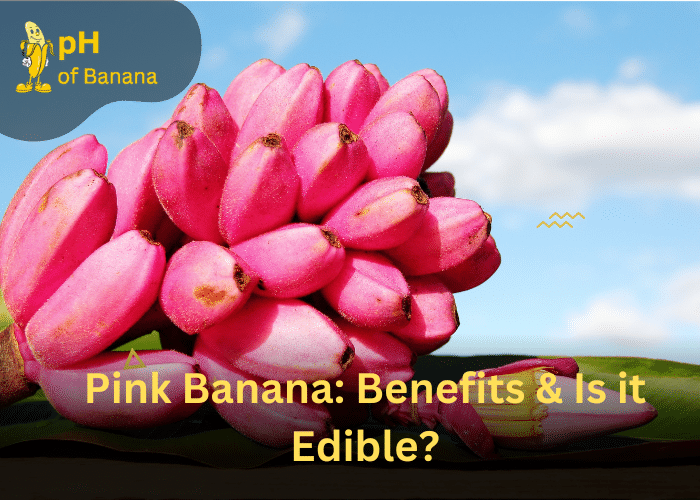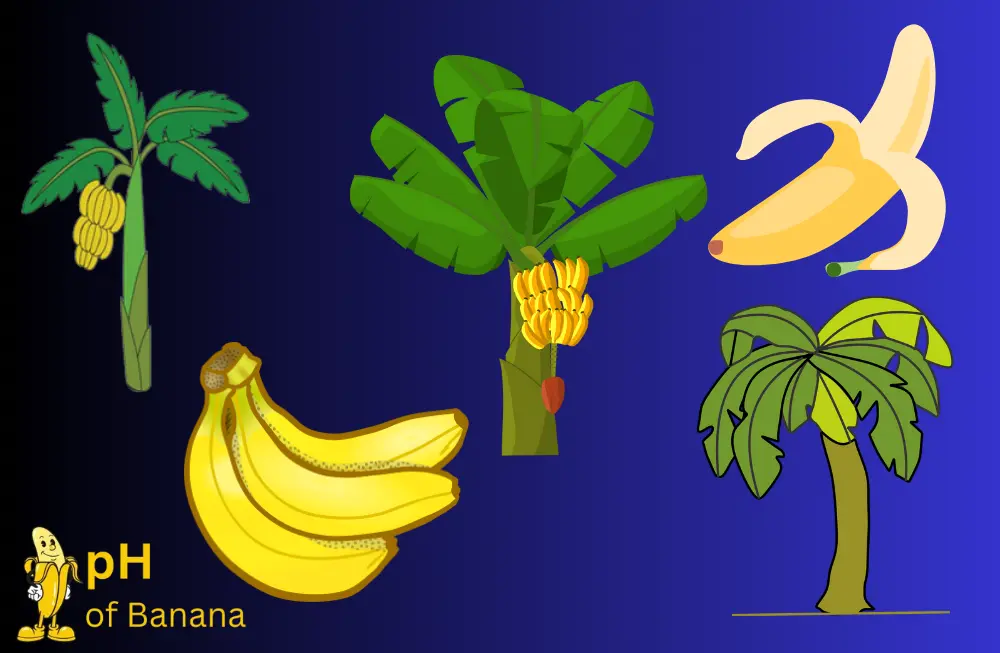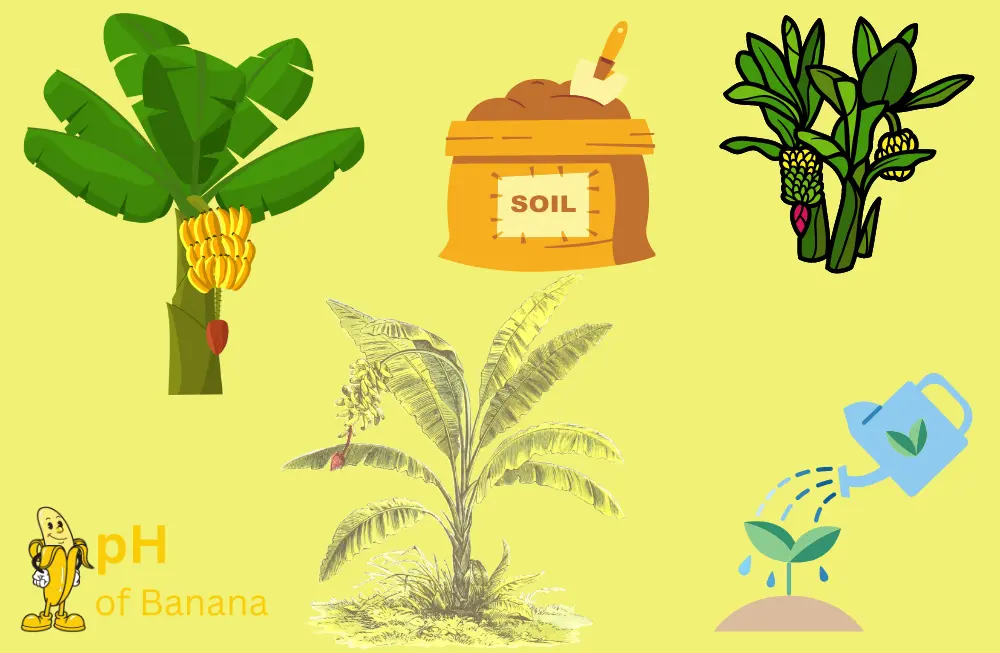Have you ever heard the term banana fiber? Yes! That exists! It’s a natural fiber from the banana plant ((Musa sepientum)!
The Banana plant is not only popular for delivering delicious fruit but it is a good source of a textile fiber, named Banana fiber. Banana fiber or lingo-cellulosic fiber is a good quality bast fiber with relatively high-profile mechanical properties.
The textile fiber industry is latterly buzzing with banana fiber as it is able to produce sustainable, eco-friendly, and enough innovative fashion products. Worldwide designers are showing their eagerness to incorporate this banana fiber into their collections to promote a sustainable alternative to various conventional fabrics like cotton and synthetic.
That’s not the end! There is far more information that should come into your knowledge. Keep on reading our comprehensive guide to know about banana fiber uses along with its advantages, and disadvantages.
What is Banana Fiber?
Banana fiber or popularly known as banana silk in the textile industry is an eco-friendly natural fiber that is derived from banana stem. It is a naturally produced fabric, having thick-walled cell tissue that is bonded by natural gums. Also, it is a good composition of cellulose, hemicelluloses, and lignin, making it a sustainable alternative to synthetic materials in the textile sector.
Making banana fiber from banana peels was first introduced in the Philippines. The productive island is highly known for producing a large number of banana trees. Along with eating, the majority of the people are involved here in making banana fiber for centuries.
Aside from the Philippines, many other Asian countries come ahead to produce banana fiber in large content. Like India, it is considered the world’s biggest hub for banana fiber.
Characteristics of Banana Fibers
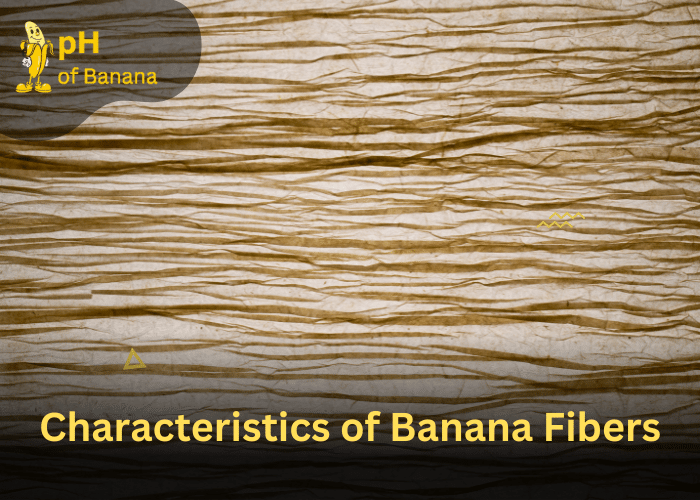
Banana fibers are like a sort of agricultural waste from banana cultivation that has both physical and chemical characteristics. All that is enough to turn this fiber type sustainable and strongest than other available fiber. Take a look at the best characteristic of banana fiber:
#1- Fineness and spin ability
Though banana fiber is almost similar to bamboo fiber and ramie fiber, it’s enough better in the case of spin ability, making it one of the finest fibers among the availability. Due to high spin ability, it’s easier to bring a shiny appearance to the made cotton or fabric. The average fineness of this fiber is 2400Nm.
#2- Chemical composition
Banana fiber is a strong fiber having a good composition of chemical properties. That includes cellulose, hemicellulose, and lignin.
#3- Elongation
Elastic elongation is quite an important factor in textile fiber as the fiber without elasticity would hardly be useable. If it is higher in amount, that would resist breakage which enhances fiber and spun yarn quality. In the case of banana, it has smaller elongation.
#4- Good moisture absorption quality
Banana fabric has strong moisture absorption quality. Along with the absorption, it releases moisture at the same motion.
#5- Water & Heat Resistant
Banana fiber has good flame-retardant properties that can be used in many applications. In addition to this, it is naturally water resistant as well, making it one of the reliable fiber elements for certain industrial and fashion applications.
#6- Bio- degradable
Banana fiber is mostly known as eco-friendly fiber. Without any doubt, this fiber is bio-degradable which has no negative effect on the environment.
#7- Durability
Generally, banana fiber is made from a tough outer sheath. Unlike other well-class fibers like hemp and bamboo, it may not prove enough durability starting from fabric making process to the usage.
#8- Insulation
No! Banana fiber is not particularly insulating.
#9- Comfort
Fabrics from banana fiber are anti-allergic and lightweight which will be enough to give you a comfy feel.
Properties of Banana Fibers
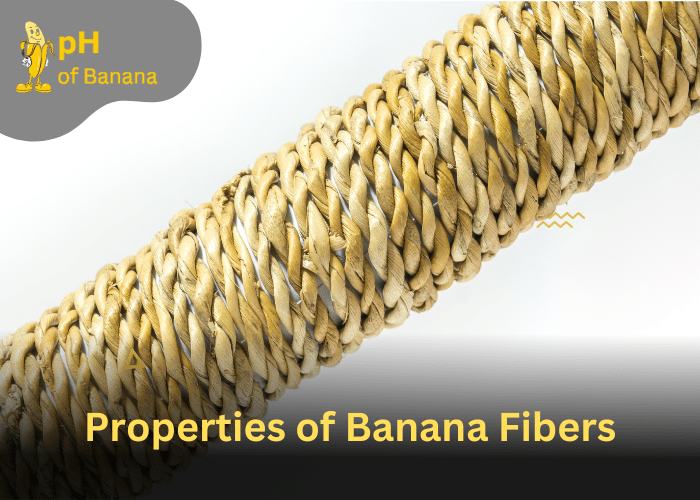
Banana fibers are certainly best compared to the other fiber, containing good mechanical properties. Now let’s have a glimpse of the physical properties of banana fiber through the below quick table:
| Tenacity | 29.98 g/denier |
| Fineness | 17.15 |
| Moisture Regain | 13.00% |
| Elongation | 6.54 |
| Alco-ben Extractives | 1.70% |
| Total Cellulose | 81.80% |
| Alpha Cellulose | 61.50% |
| Residual Gum | 41.90% |
| Lignin | 15.00% |
| Tensile Strength (Mpa) | 529-914 |
| Specific Tensile Strength (Mpa) | 392-677 |
| Young’s Modulus (Gpa) | 27-32 |
| Specific Young’s Modulus (Gpa) | 20-24 |
| Failure Strain (%) | 1-3 |
| Density (Kg/m) | 750-950 |
Is Banana Fiber A Natural Fiber?
Yes! No doubt to say that banana fiber is a natural fiber that is extracted from the pseudostem of the banana plant. This naturally obtained banana leaf fiber is highly popular & widely used in the fashion and technical textile industries as a sustainable, eco-friendly, biodegradable fiber class.
We use the term natural fibers to refer to such fibers that are obtained from another animal or plant. In the case of plant fiber, that can be collected from the leaves or trunk of certain plants like banana fibers. Consequently, the banana plant is a rich source of good-quality textile-grade fibers.
The fiber collected from the banana plant is strong enough for the preparation of high-quality textiles, and even it can be easily blended with cotton fiber or other synthetic fibers in order to form a blended fabric as well. So, there should be no confusion that banana fiber is one such natural source, derived from the pseudostem of the banana plant.
Why Is Banana Fiber Good?
Banana fibers are good quality organic fibers that are far different from other organic fibers due to their high tensile strength and spin ability. Even it is regarded as the world’s strongest natural fiber. Despite the textile industries, banana fibers are incredibly good for the human body as well. Consuming an adequate amount of bananas daily, the fiber content will significantly reduce heart disease, stroke, hypertension, LDL-cholesterol, and so on.
Let’s have a glimpse of the great benefits of banana fibers:
| Health benefits | Improved blood sugar levels |
| Support the digestive health | |
| Good for heart health | |
| Help ease inflammation | |
| Helps in weight loss | |
| Cure for constipation | |
| Textile profile | Biodegradable |
| Durable | |
| Heat resistant | |
| Good spinning ability | |
| High tensile strength | |
| Low density & appropriate stiffness | |
| Water and UV Resistant | |
| Versatile Usage benefits | Textiles |
| Paper products | |
| Non-woven products | |
| Industrial products |
How Many Types Of Banana Fiber Are There?
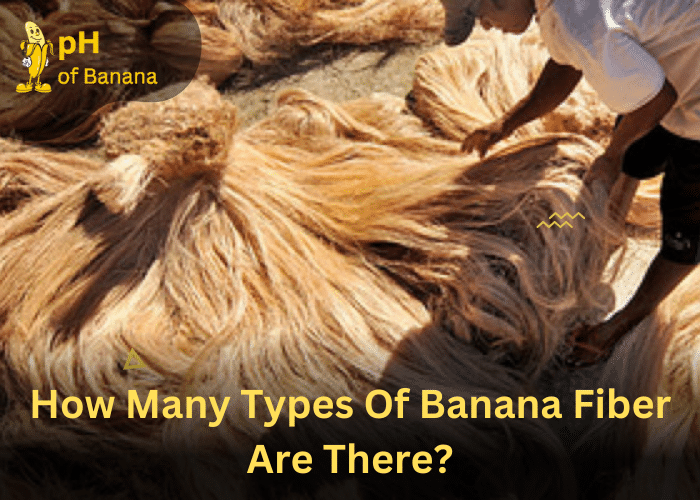
There are mainly two types of banana fiber available in this world. One is the outer peel and the other one is the inner peel. But when it is combined with other natural fibers, they turn into a new form.
Here are four typical types of banana fiber that should come to your knowledge:
1# Inner-peel banana fiber
This is regarding a very soft and delicate fiber class that is almost similar to silk. Generally, it is enough expensive to produce.
2# Outer-peel banana fiber
These types of banana fibers are typically rough and coarse fibers that are widely used for ropes, mats, and thick outerwear and garments.
3# Banana Cotton
This is basically high-grade outer-peel banana fiber. Mostly it is known as cotton due to having a similar texture and many other attributes.
4# Banana Silk
“Banana silk” is another form of inner-peel banana fiber that is almost similar to silk in properties.
How Strong Is Banana Fiber?
Due to its high chemical properties, Banana fiber is considered to be an extremely strong fiber. The mechanical strength values are specified in a few different levels. That includes tensile strength, flexural strength, impact strength, and hardness.
| Tensile strength | 52.57 MPa |
| Flexural strength | 70.35 MPa |
| Impact strength | 155.45 J/m |
| Hardness | 23.8 Hv |
Natural fibers are generally not stronger than synthetic fibers. Due to the cultivation of plants, at times, the tenacity of the fiber is not strong enough. But in the case of banana fiber, the strength is almost robust compared to the other organic fiber.
Apart from the high tensile strength, another substance that makes the fiber strongest is lignin, making it the toughest fiber that can be easily sued for making paper, bags, ropes, and floor coverings.
How Is Banana Fiber Made?
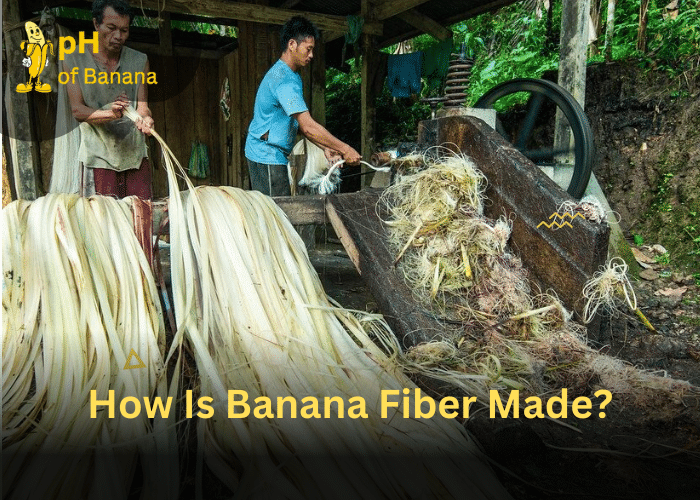
Processing the banana fiber into fabric includes long-term laborious methods that start from separating the non-usable components from the fiber. Then they are together for bunching and drying. After separating the fiber into groups, they are sent for spinning into yarn. After being treated and dyed in the yarn, the fiber turns into garments.
Don’t get puzzled just after seeing the preview. We’ve disclosed the step-by-step procedures for making the banana fiber into the fabric:
Step #1: Separation
As for the first step, the banana fibers are sent for a separation process. In this process, the fibers from the banana and stems are separated from the non-usable components. To do this, various techniques are applied like retting. It is basically the banana peels that are soaked in water or a chemical substance to soften and separate the unusable parts.
Step #2: Bunching and drying
After separating the non-usable components from the fibers, they are sent for bunching and drying. During this process, the inner and outer parts of the fibers are kept together as it is enough tough to separate them when wet.
Step #3: Dividing into groups
At this stage, the fibers need to separate into two or more groups based on quality. Like, the best-of-the-best are labeled as “A” group, which is used for silk-alternative applications. Through this process, a variety of different banana fibers are produced based on grades.
Step #4: Spinning and weaving
This is the fiber spinning process into yarn. The separated banana fibers spun into yarn. Here the fiber is well treated and dried that forms garments, accessories, and decor items after weaving.
How Is Banana Fiber Different From Other Fibers?
Banana fibers are certainly different from the other fibers as they are extracted from the inner or outer peel and stem lining of banana plants. In most cases, it is regarded as one of the good go-on alternatives to all synthetic and natural fibers. These fibers tend to be eco-friendly, chemical-free, non-toxic, and most importantly odor-free. Also, it is the complete package of all the high chemical properties, hardily found in other varieties of banana fiber.
- In general, banana fiber is almost similar to bamboo fiber and ramie fiber. But when the term comes to fineness and spinnability, they are far better than the two.
- It is a highly strong fiber compared to the other fibers.
- The core chemical composition of banana fibers is cellulose, hemicellulose, and lignin. But when you are comparing banana fiber to 100 % cotton fabric, you will get up to:
- 15 % higher tensile strength
- 22 % superior tear strength
- 15 % superior airflow
- And 30 % higher friction resistance.
- The majority of the chemical properties of Sisal fibers are almost similar to banana fibers except for a few. Let’s have a glimpse at the below-comparing table:
| Sisal fiber | Banana fiber | |
| Hemicellulose | 12 % | 6-9 % |
| Lignin | 9.9 % | 5-10 % |
| Cellulose | 65 % | 60-65 % |
Advantages Of Using Banana Fiber
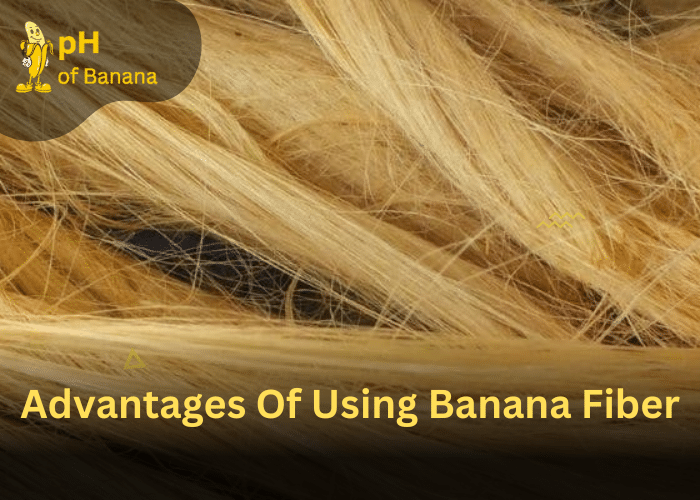
Note down a few notable advantages you can ensure by using the banana plant for growing fiber:
#1- Minimal impact on soil health
In the case of growing the banana plant, there will be a low impact on the soil. The roots of the banana tree are strong enough. That is why the banana trees can re-grow in the same place where other fiber plants need to re-fertilize the soil.
Also, it does not require any additional water and soil. The natural ecosystems of intensive banana production systems have negative effects on soil health like erosion or low energy.
#2- Non-Toxic
Banana fibers are certainly non-toxic as it doesn’t require genetically modified crops. Due to that, it can ensure a long sustainable livelihood for the farmers. Also, non-toxic banana fibers have great advantages in fabric as well, as it does not contain dyes – so no chemicals. Moreover, the fabric is far improved in comfort, softness, and durability, thus you will not feel itchiness or any type of discomfort while using the fabric.
#2- Low Water Usage
Banana fabric typically has minimal impact of its low water consumption. Basically, the plant fiber is from parts of the banana tree and banana peel that tend to have low water consuming. Thus it will be a great savage of energy as well.
#4- No Wastage
Banana fibers are from the banana trunk or peel which is almost waste. Thus forming a great fiber from the waster past from the plant is definitely can be one of the best alternatives to several other synthetic and natural fibers.
What Is The Disadvantage Of Banana Fiber?
Despite the great diversity of advantages, banana fiber has some major drawbacks as well that affect composite production. Have a glimpse of some notable disadvantages of banana fiber:
#1- Lower availability
These natural fibers aren’t generally widely available, unlike other natural fibers. This is because there has long been a source of fiber-making process from the banana plant.
#2- Water resistant
As we have already mentioned banana fiber is tend to be water resistant fiber.be It is not as absorbent as cotton, thus the fabric processed from it can be a bit uncomfortable to wear in hot and humid climates.
#3- Color limitation
Unlike other natural or synthetic fibers, there are limited color options in banana fibers.
#4- Hard labor in processing
The fiber-making process from the banana plant certainly requires hard labor and a longer time. To perform all these perfectly, there need skilled workers and specialized equipment.
What Is Banana Fabric Used For?
Banana fiber is used to customize different things based on the types of banana fibers. The inner and outer peel banana fabric has different uses. The inner lining is quite soft and delicate which is almost related to the silk. It is certainly a good alternative for garments made from silk like blouses, shirts, negligees, lingerie, slips, gowns, and so on.
But that’s not the end! Have a glimpse of the wide usages of banana fabric in different sectors:
1# Accessories
Banana fiber is highly used to make different types of accessories like scarves, hats, gloves, and many more organic products. The customization of various accessories from banana fiber is increasing worldwide day by day due to its sustainability and durability.
2# Decor Items
The banana is highly popular for making tropical-themed decor items. Earlier, it is only limited to forming a few items like ropes, doormats, or wall leaves. But as technological development, it has broadened up its use to make various decor items.
3# Sanitary Napkins
The term may surprise you that environmentally friendly sanitary pads can be customized from banana fiber. Yes! That’s possible. Even The International Institute for Environment and Development has launched a program just to educate women to make sanitary pads out of banana fibers that will be not only hygienic, and user-friendly but also enough affordable too.
4# Japanese yen notes
From earlier 1944, banana fibers are used to utilize the Japanese yen notes due to their strength and durability. The banana fibers are sent for weaving where integrates into paper. Even these papers are much stronger than regular paper and quite good wear and tear-resistant as well.
5# Tea bags
Banana fabrics are used to make compostable tea bags as well. Basically, a special kind of Philippine banana tree abaca hemp is used here. Abaca hemp is also known as Manila hemp. It is like a mesh-type material that easily allows water to flow through while retaining the tea leaves. These tea bags are enough eco-friendly and sustainable compared to the traditional tea bag made of paper or plastic
6# Car tires
Banana fiber is highly popular in the automotive industry as well. Banana fibers are enough lightweight, sustainable, biodegradable, and a good alternative to synthetic mater. Thus various manufacturers worldwide are exploring the use of banana fiber in manufacturing car tires as well.
How Do I Look After Fabrics Made From Banana Fiber?
You need to ensure a special concentration while cleaning the fabric from the banana fiber. It’s always best to steam iron the fiber garments. Streaming the fabrics with gentle iron will easily remove the creases or wrinkles. In the case of washing, you can do it by your hand or you can put it in the washing machine as well. If it is blended with other fabrics like silk, take care of it as other fabrics in the blend.
Is Banana Fiber Soluble Or Insoluble?
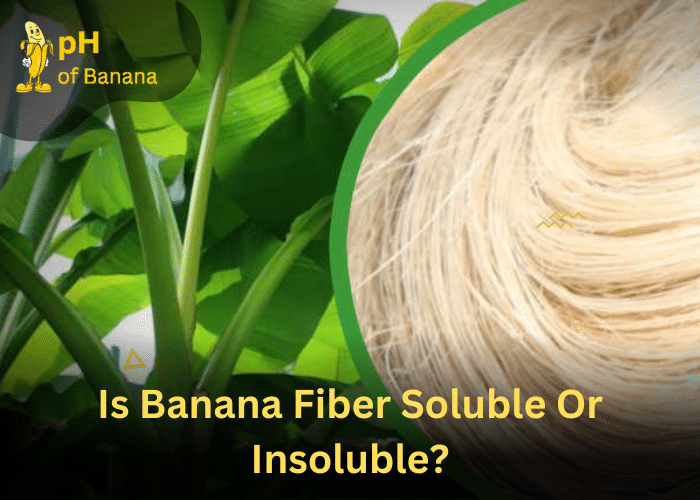
Banana contains both soluble and insoluble fiber in a specific amount. In a medium-sized banana, there are about 3 grams of dietary fiber, of which only 1 gm comes from soluble fiber. The rest of the fiber amount is derived from insoluble fiber. Basically, soluble pectin is good for health that is converted from the resistant starch of a ripened banana. This pectin fiber is easier for humans to digest.
Let’s make this concept clear….
Soluble fiber mainly tends to be water-absorbent. Due to high water absorbent, it makes a soft, gel substance in the body that slows the digestive process. But the insoluble fiber does not absorb water. For that reason, it helps to regulate the bowels and add bulk to the stool which speeds the movement of food through your digestive tract. In this way, it improves the digestive process.
Banana Fiber Prices
The prices are varied based on the banana fiber type. The inner-peel banana fibers are almost similar to the silk fiber thus it is enough expensive. This inner-lining banana fiber has great market value. Compared to that, the outer-lining fabrics come at affordable prices.
There is a wide array of market resellers and reputable online platforms that exclusively bring and sell banana fiber. The prices will differ based on the process and manufacturing type. In general, the average market price of Banana Fiber is Rs 150-200/ Kilogram in India.
Does Banana Or Apple Have More Fiber?
Both apples and bananas are highly rich in dietary fiber. But banana contains slightly more up to 8% higher fiber content than apple thus it is far more effective in gut health and promoting satiety. You would expect to have up to 2.4g of dietary fiber per 100 grams of apple whereas banana has 2.6g.
Apples are among the tastiest fruit that is relatively high in fiber. Especially the skin contains the majority of healthy phytochemicals and fiber for why the doctors suggest eating apples without peeling them. In this way, you can ensure more benefits in gut health. Basically, the pectin fiber of the apple acts as a prebiotic, meaning it feeds gut microbiota and performs a good role in overall gut well-being.
Unlike apple, banana is also high in fiber. One medium-sized green banana contains more than 3 grams of fiber, while a ripened banana possesses less than that. The fiber distribution in bananas differs based on ripening levels.
What Has More Fiber Orange Or Banana?
Both oranges and bananas are rich in various fibers. But bananas have slightly more dietary fiber compared to the orange. Per 100 gm of orange, you will get about 2.4g of dietary fiber whereas banana has 2.6g. That means you are sensing up to 10% more fiber in a banana than orange.
So from the above comparison factors, it is clear that Bananas are healthier than oranges. They are offering more fiber that can be highly helpful in regular digestion, reducing heart diseases risk, and even maintaining a healthy weight.
Which Has More Fiber Banana Or Sweet Potato?
Sweet potatoes are extremely high in fiber. It has 15% more dietary fiber than a banana. You will get up to 3g of dietary fiber per 100 grams whereas banana contains 2.6g.
Both bananas and sweet potatoes are excellent sources of fiber. In a nutrition battle, the sweet potato will come in ahead. A medium-sized cooked sweet potato contains more fiber 3.8 grams. These are both soluble and insoluble. The soluble fibers come in the form of pectin whereas the insoluble (77–85%) are in the form of cellulose, hemicellulose, and lignin.
Which Has More Fiber Banana Or Papaya?
Bananas are an extremely great source of dietary fiber, which has upto 53% more dietary fiber than papaya. From a 100-gram of papaya serving, you are getting only 1.7g of dietary fiber whereas the banana has about 2.6g.
When Should I Eat Banana For Fiber?
There is no recommended time for eating bananas in a day. It can be anytime during the day except on an empty stomach. You can eat a banana for breakfast with other foods to promote satiety and aid digestive health. Or, many of us prefer to eat bananas before bed as well. As it is full of nutrients and fiber, making it is easier to boost the digestive system overnight and improve gut health. Even it helps to aid your sleep cycle as well.
Is 1 Banana A Day Enough Fiber?
Bananas are a healthy addition to our regular diet. One medium-sized banana provides you with nearly 10% of your daily recommended intake of fiber through the 3.1 grams of this nutrient. In this regard, eating one or two bananas will be enough to fill the fiber need of your body.
Our body is a complex system that requires an adequate amount of nutrients on the daily basis to keep it healthier. We need to eat various types of foods to fulfill all our nutrient needs.
When the query starts on how many bananas should you eat daily, there is no specific amount recommended by the expert and doctors. It depends on the nutrient needs. You can eat as many bananas as you want but the amount should not go so far that it will lead to weight gain and nutrient deficiency.
Basically, one to two bananas per day are enough to maintain the nutrient density of the body.
Is Banana Fiber Good For Constipation?
No doubt to say that, the soluble fiber content of bananas is a great treatment for constipation. Ripe bananas contain 3 g of fiber per 120g of serving mostly in the form of soluble fiber. It is also highly rich in amylase-resistant starch and tannins. All these combinedly act as an effective aid for the constipated patient.
#- Keep note that, to treat a constipation problem, the banana must be ripe. An unripe banana is highly rich in resistant starch which has a low water-binding capacity, leading to constipation. Due to that, it is served to treat diarrhea.
Frequently Asked Questions (FAQs)
Which country is the largest producer of banana fiber today?
India leads in banana production worldwide which provides about 28.4 million tonnes in amount per year. This country is accounted for 22% of total global banana production.
Is Banana Fiber Heat Resistant?
Yes! Banana fibers are heat resistant due to that, and Banana fiber clothing is comfortable to wear.
Is Banana Fiber Water Resistant?
Yes! Banana fibers are naturally water-resistant.
Is Banana Fiber Sustainable?
Yes! Banana fibers are quite sustainable materials that are easily available in nature through banana plants. Moreover, it has the great advantage of being lightweight, biodegradable, eco-friendly, and having high specific chemical properties.
In Closing
That’s all from us here for you! Hope that there should be no confusion left over on how to form the banana fiber into textile products and about their greater usage. Consumers and businesses seek are always on the hunt for sustainable materials. For this instance, banana fiber is emerging as the top place in the textile industry.
Due to having endless benefits and its exceptional strength in its unique texture, the banana plant is gaining popularity not only in fruiting herbs but also in economical sectors in various well-developed countries. We’ve already explored the advantages of this sustainable material. Thanks for being with us!
Also Read:
Sodium In Banana [ Nutritional Information & Health Benefits]

